Drafts by Gregory Bassham
Many Tolkien scholars have claimed that The Lord of the Rings and other tales of Middle-earth sub... more Many Tolkien scholars have claimed that The Lord of the Rings and other tales of Middle-earth subtly affirm a traditional approach to morality now known as "virtue ethics." In this paper, I argue that Tolkien did embrace a version of virtue ethics--specifically an Aristotelian-Thomistic one--and sum up (in brief) the evidence for this reading.
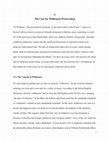
The Case for Wilderness Preservation "In Wildness," Thoreau famously declared, "is the preservati... more The Case for Wilderness Preservation "In Wildness," Thoreau famously declared, "is the preservation of the World." 1 America is blessed with an extensive system of federally designated wilderness areas, amounting to nearly 5% of the land mass of the United States. Each year, millions of hikers, backpackers, and other wilderness enthusiasts venture into the American backcountry to experience nature in its primeval, undeveloped state. The idea of setting aside large tracts of scenic, nearly pristine public lands for national parks and protected wilderness areas has been called "America's best idea" by documentary filmmaker Ken Burns. 2 Yet there are many critics who question the whole idea of wilderness preservation, or at least what some call "the received view" of wilderness. In this chapter let's look at the case for and against wilderness preservation. 13.1 The Concept of Wilderness We must begin by getting clear on what we mean by "wilderness," for the word has changed meaning over time and is now used in a variety of senses. According to the Oxford English Dictionary, the term "wilderness" derives from the Old English word wild-dēor-ness, meaning "the place of wild deer." In the Bible, the Hebrew and Greek terms that are standardly translated as "wilderness" connote an arid, uninhabited wasteland. 3 In this sense, wilderness was seen as a hostile and dangerous place, an abode of evil and desolation, the antipode of the paradisal Garden of Eden. This negative Judeo-Christian view of wilderness was long dominant in Western civilization and strongly influenced early European settlers' views of the vast American forests and their "savage" native inhabitants. 4 A more positive view of wilderness emerged with the nineteenth-century Romantic movement, when thinkers such as William Wordsworth, Henry
Many scholars have claimed that Tolkien embraced and taught in his fantasy fiction an approach to... more Many scholars have claimed that Tolkien embraced and taught in his fantasy fiction an approach to morality known as "virtue ethics." 1 Yet rarely do such scholars clearly explain what virtue ethics is or what reasons there are for thinking that Tolkien subscribed to it. That will be my goal in this paper. What Is Virtue Ethics? Virtue ethics is currently one of the three leading theories of normative ethics. 2 It is an old way
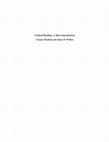
Critical reading analyzes a written work. To analyze something is to divide it-to break it into p... more Critical reading analyzes a written work. To analyze something is to divide it-to break it into parts-in order to understand it better. Any reasonably complex text has a certain structure. A typical argumentative essay, for example, will include various claims and assumptions, together with certain conclusions that are said to follow from those claims and assumptions. To judge whether the argument is any good we need to see how its parts hang together. Are the claims and assumptions really true? Does the conclusion actually follow? To find out we need to analyze the argument's structure to pick out its components. Critical reading evaluates a written work. The word "critical" has several meanings. In one sense it means inclined to fault or judge others harshly. When we speak of critical reading, however, "critical" means "discerning" or "skilled in judging." It's the skillful judging that separates critical reading from plain old vanilla reading. In reading a piece of argumentative writing, the bottom-line question is always: "Is the argument any good?" "Has the writer given good reasons to support his view?" This book will help you make such judgments more accurately and intelligently. The Benefits of Critical Reading Being a reader-especially an enthusiastic and skilled reader-has a number of obvious practical benefits. Reading can help students earn better grades, do better on college-admission tests, improve their vocabularies, sharpen their powers of concentration, and improve their writing skills. But there are other important benefits of reading. Here are four major ones: We read for information and instruction We read instructions, recipes, movie times, box scores, and other purely informative sources. We also turn to textbooks, online and print encyclopedias, history books, newspapers, magazines, journals, how-to manuals, advice columns, and many other sources for the information and practical guidance we need to understand, survive, and participate in our world. The information we seek needn't be immediately useful. We may read to discover where an opposing political party stands on an issue or how another religion deals with the notion of an afterlife, or we may simply be curious to know how others look at the world. Without question, instructional videos, documentaries, news reports, and photographs provide helpful information on a range of topics, but reading permits us to investigate issues-especially complex issues-that cannot be fully developed in visual media. And even if in the future all known information were available in visual media, some people simply learn and retain more of what they read than what they see, which means that reading for information, at least for some people, will always be necessary. We read for entertainment As with reading for information, some people simply prefer to read for entertainment rather than watch television or go to movies. We might read to laugh, cry, tremble, escape or dream. This particular motivation may seem to be vanishing as fewer and fewer people turn to works of the imagination-novels, short stories, and poems-for the sheer enjoyment of reading. Literature, however, is not the only reading that provides pleasure. Many readers enjoy biographies, histories, memoirs, critical reviews, and other non-fiction forms of writing. While these genres might provide information, many people read them just as much for the joy of turning words into meaning, reveling in the beauty of language or an author's unconventional or eloquent style, imagining the world depicted on the page, and escaping into imagined or historical places. And the best thing is that the more we read, the more things we find interesting and worth exploring. Readers with a good book in their hands don't ever have to worry about being bored. 2 A few centuries ago, books often had long, highly detailed titles or subtitles. For instance, here's the subtitle of George Berkeley's classic Three Dialogues Between Hylas and Philonous (1713): "The Design of Which Is Plainly to Demonstrate the Reality and Perfection of Human Knowledge, the Incorporeal Nature of the Soul, and the Immediate Providence of a Deity, In Opposition to Skeptics and Atheists. Also to Open a Method for Rendering the Sciences More Easy, Useful, and Compendious." almost nothing about what the books are about. (And no, it wouldn't help even if you knew what an "Ennead" was. 3) 2.2 Read any publishers' descriptions of the book on the dust jacket or back cover, as well as any "blurbs" (endorsements) on the back cover. Publishers' jacket copy often provides a helpful overview of a book's main themes. Keep in mind, though, that such copy is generally written by the publisher's marketing department, and is intended to make the book sell. Blurbs, too, should be approached with caution. Often blurbs are written by personal friends of the author (who naturally praise it to the skies) or by famous authors or other notables (who sometimes don't even read the books they are endorsing). In short, expect and beware of hype. 2.3 Read the Preface, the Introduction, and the Editor's Introduction. Not all books have Prefaces, Introductions, or Editor's Introductions, but read these if they are included. Prefaces and Introductions frequently provide thumbnail sketches of a book's central claims and lines of argument. Many classic texts are published with helpful Editors' Introductions, often written by top scholars. Such Introductions may provide useful information about the author, the historical context of the work, as well as other aids to understanding. 2.4 Read the Table of Contents. A good Table of Contents is like a trip itinerary. It tells the reader where he or she is going by indicating the main topics covered in the book ("The First Amendment") and often the author's particular views on these topics ("Why Campaign-Financing Laws Don't Violate the First Amendment"). 3 "Ennead: Set of nine (discourses, books, points)." (The Concise Oxford Dictionary.) 2.5 Dip into the book, glancing at major section headings and reading the opening and closing paragraphs of key chapters. Section headings are signposts that alert readers to the topics being discussed. Major claims and conclusions are often found at the beginning or end of chapters, and brief summaries of important points are sometimes included at the end. 2.6 Read the last two or three pages of the book. Authors frequently use the last few pages of their books to sum up key points or sketch its broad implications. How to Skim Articles or Chapters Suppose you're tackling something shorter than a book-say, a textbook chapter, a scholarly article, an editorial, a news article on the Web, or a blog. Here skimming becomes a little easier. Not only is there less text to skim, but generally there are no prefaces, tables of contents, dust jackets, and other bookish apparatuses that need to be attended to. To skim articles and chapters, try the following: 2.7 Read the Title and Subtitle. Titles typically inform readers of the general topic of the chapter or article ("Educational Equality of Opportunity"); subtitles often indicate the author's specific focus or approach to the overall topic ("A Feminist Analysis"). 2.8 Read the Chapter Learning Outcomes. Many textbooks, especially newer ones, begin chapters with a short list of learning objectives ("After you study this chapter, you will be able to. . ."). These can provide a helpful map of the chapter's general contents. 2.9 Read the Chapter Summary. Textbook chapters usually include a concluding section titled "Chapter Summary," "Conclusion," "Summary of Main Points," or something similar. Read this carefully. It's the quickest way to get the highlights. 2.10 Read the abstract or editor's introduction. Many scholarly articles are preceded by helpful abstracts that summarize the article's main points. Textbook anthologies often include brief editorial introductions to the readings that provide useful information about the author and the central themes of the reading. 2.11 Read the introductory and concluding sections. The main idea of the chapter or article will most likely be stated at the beginning or end. 2.12 Read any subheadings. These indicate the main topics discussed in the article or chapter. 2.13 Read the first sentence or two under each subheading. The key idea of a section will most likely be stated in the first few sentences. 2.14 Look for key words and graphic indicators such as boldface, italics, bulleted lists, graphs, or charts. Textbooks, in particular, often use typographical and graphic aids to guide readers to important definitions and help them grasp key concepts. Keep in mind that that these are just general guidelines or rules of thumb. Skimming strategies that work for, say, an economics textbook chapter might not work for an online news story or a scholarly article. But since you've read this chapter closely, rather than merely skimmed it, you know that already. Chap. 3: Close Reading Close reading is careful, thorough, active reading. When we read closely we read an entire work (book, article, encyclopedia entry, etc.), we read it carefully and attentively, and we actively question and engage the text in order to understand it as fully as possible. To become really good at close reading isn't easy. Close reading is an art that requires practice, a good vocabulary, relevant background knowledge, as well as intellectual habits and abilities, such as patience, perseverance, mental focus, and powers of logical analysis. You won't become a skilled reader simply by reading this textbook or any other. But here you'll find all the basic principles of close reading. If you follow these principles and apply them, then with effort you can become an adept reader. The Logistics of Close Reading: Time and Place Casual reading can be done in crowded subways, on noisy beaches, in doctors' offices, at the breakfast table, almost...
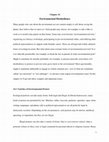
Many people who care about the environment are not content simply to talk about saving the planet... more Many people who care about the environment are not content simply to talk about saving the planet; they believe that we must act. Such people may choose, for example, to ride a bike to work or to install solar panels on their home. Some may even become "environmental activists," organizing eco-literacy workshops, participating in pro-environmental rallies, and lobbying their political representatives to support earth-friendly causes. These are all legal and widely admired forms of ecological action. But what about more extreme forms of environmental activism? Is it ever ethically permissible, for example, to break the law in pursuit of some environmental goal? Might it sometimes be morally justifiable, for example, to practice peaceful, nonviolent civil disobedience to protest or prevent some grave harm to the environment? More questionably, might it sometimes defensible to engage in violent criminal acts-acts of what are sometimes called "eco-terrorism" or "eco-sabotage"-to advance some urgent environmental cause? In this chapter we'll get into these complex and important issues. 14.1 Varieties of Environmental Protest Ecological protests can take many forms, both legal and illegal. In liberal democracies, many kinds of protest are permitted by law. Marches, rallies, boycotts, petitions, speeches, signs, letterwriting campaigns, and phone calls to political representatives are all perfectly legal in democratic societies. Depending on the circumstances, such protests may be unwise, unethical, upsetting, or imprudent, but they are not illegal. Illegal protests can also take a variety of forms. One is conscientious refusal, when a protester refuses to obey a law or legal command for personal ethical or religious reasons. Henry
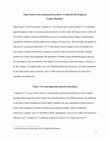
Pope Francis's 2015 Encyclical "Laudato Si': On Care for Our Common Home" 1 is a landmark papal d... more Pope Francis's 2015 Encyclical "Laudato Si': On Care for Our Common Home" 1 is a landmark papal document on the environment and social justice. In this work, the Francis issues a bold call for action to address urgent environmental concerns, including climate change, environmental degradation, pollution, and the rapid global collapse of biodiversity. More broadly and deeply, he calls for an "ecological conversion" (217) 2 that entails radical changes in the way people live, view nature, treat the environment, organize social life, and act toward one another. Though written very clearly and engagingly, the document is lengthy (about 80 printed pages) and may be confusing to some not familiar with Catholic social teaching. In this brief paper, I shall try to do three things: (1) explain what's new and important about the document, (2) briefly summarize its principal claims and conclusions, and (3) offer some personal reflections on some of its strengths and weaknesses. What's New and Important about the Encyclical "Laudato Si'" is an encyclical, which is an especially solemn and authoritative form of papal teaching. Most papal encyclicals tend to be focused narrowly on Catholic doctrine, are addressed to the Pope's fellow Bishops or to the Catholic faithful, cite only authoritative Church sources (such as the teachings of Church Councils, prior papal documents, reports of Bishops' conferences, and the views of venerable Catholic theologians), and are not widely read outside of Church circles. "Laudato Si'" is different in all these respects. It is addressed to all of
I thank Professor Williams for his thought-provoking reply. Williams's response is lengthy, and I... more I thank Professor Williams for his thought-provoking reply. Williams's response is lengthy, and I cannot, in the brief space permitted, reply to all of his counterarguments. Readers should not assume that silence implies assent.
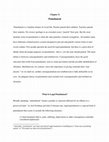
Punishment is a familiar feature of social life. Parents punish their children. Teachers punish t... more Punishment is a familiar feature of social life. Parents punish their children. Teachers punish their students. Pet owners (perhaps in an extended sense) "punish" their pets. But the most dramatic form of punishment is when the state punishes criminal wrongdoers. All modern states have elaborate criminal justice systems designed to prevent and punish various forms of antisocial conduct. Few people question the need for legal punishment, but there is a great deal of debate about the proper purposes of punishment-that is, why the state should punish. The main debate is between consequentialists and retributivists. Consequentialists stress the good outcomes that result from punishment, such as crime prevention and the possible rehabilitation of offenders. Retributivists, by contrast, stress the importance of giving criminals their "just 1 Informally, "punishment" can mean any kind of rough treatment or handling (as in "Jones was a punishing tackler" or "This watch can take a lot of punishment").
Lord of the Rings author J.
has described the Harry Potter books as "a prolonged argument for tolerance, a prolonged plea for... more has described the Harry Potter books as "a prolonged argument for tolerance, a prolonged plea for an end to bigotry." 1 This is reflected, among other ways, in the books' attacks on claims of superiority based on race, gender, purity of blood, magical abilities, wealth, celebrity status, and other such grounds for alleged class distinctions. Rowling is a strong critic of any kind of pecking order between wizards and Muggles, pure-bloods and half-bloods, full humans and part-humans, and the like. She is an egalitarian who favors a tolerant,
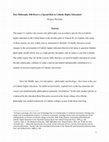
Journal of Catholic Higher Education, 2015
This paper (1) explores the reasons why philosophy was accorded a special role in Catholic higher... more This paper (1) explores the reasons why philosophy was accorded a special role in Catholic higher education in the United States in the decades prior to Vatican II; (2) explains why many of those reasons are now widely seen as attenuated or obsolete; (3) briefly discusses recent changes to the environment of Catholic higher education that have led many to question whether philosophy should still be seen as a high-priority discipline; and (4) makes a case that it should. The author argues that, for all the tectonic shifts that have occurred in higher education in recent decades, philosophy continues to make a special and indeed indispensable contribution to a number of mission-related goals of Catholic universities. Since the Middle Ages, two disciplines-philosophy and theology-have been at the core of Catholic higher education. 1 In medieval universities, required texts in the baccalaureate arts course were predominantly philosophical (primarily Aristotelian). 2 In the early modern period, as evidenced by the education René Descartes received at the Jesuit college of La Flèche, philosophy was studied extensively in Catholic colleges as part of the three-year-long 1 Perhaps surprisingly, this is less true of theology than it is of philosophy. In medieval universities, theology was taught only to postgraduate students. In American universities, theology courses were not typically part of the undergraduate curriculum at Catholic colleges until after 1939. Philip Gleason, Contending with Modernity:
The Harry Potter novels teach a number of important moral lessons. Among these are the values of ... more The Harry Potter novels teach a number of important moral lessons. Among these are the values of friendship, courage, loyalty, faith, humility, solidarity, love, nonviolence, and acceptance of death. 1 As J. K. Rowling has noted, the novels are also "a prolonged argument for tolerance, a prolonged plea for an end to bigotry." 2 Throughout the books, there is a clear and emphatic critique of all forms of prejudice, discrimination, and elitist superior-than-thou thinking.


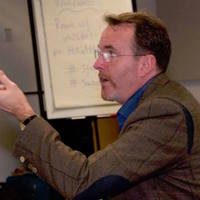
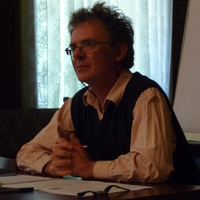





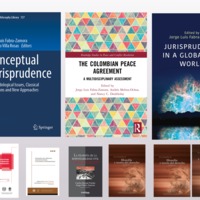

Uploads
Drafts by Gregory Bassham